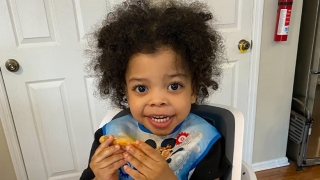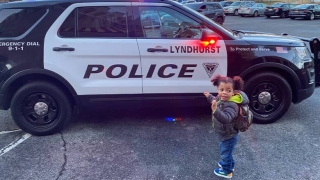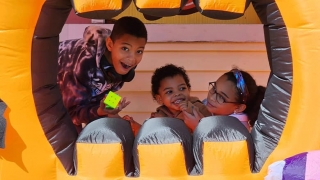Asher’s Story: Fetoscopic Endoluminal Tracheal Occlusion for Congenital Diaphragmatic Hernia
Published on
Published on
Jennifer and her husband, Gonzalo, hadn’t heard of Children’s Hospital of Philadelphia (CHOP) until the day they went for a routine 20-week ultrasound. It was the couple’s third pregnancy, so they had a pretty good idea of how long an ultrasound should last. When this ultrasound lasted more than three hours, they knew something was wrong.
 Now 3, Asher has come a long way since being diagnosed with congenital diaphragmatic hernia (CDH) before he was born.
Jennifer’s obstetrician (OB) told them the fetus had a birth defect known as congenital diaphragmatic hernia (CDH). Jennifer was overwhelmed by the news, but she took note when the physician said that CHOP was the best place to go for care for CDH.
Now 3, Asher has come a long way since being diagnosed with congenital diaphragmatic hernia (CDH) before he was born.
Jennifer’s obstetrician (OB) told them the fetus had a birth defect known as congenital diaphragmatic hernia (CDH). Jennifer was overwhelmed by the news, but she took note when the physician said that CHOP was the best place to go for care for CDH.
The couple was sent directly to a nearby medical center. After performing a more thorough evaluation, the maternal-fetal medicine specialist there reiterated the diagnosis and that CHOP was the best place for care.
“I learned that day that if any hospital knew about CDH, it was CHOP,” says Jennifer.
CDH is a very severe birth defect in which there is a hole in the forming diaphragm. That hole allows the contents of the abdomen, like the bowel, the stomach and even the liver, to come up into the chest. This causes a lack of space for the lungs to grow and develop normally in utero.
In severe cases, CDH can lead to serious disease and death at birth. CHOP offers fetoscopic endoluminal tracheal occlusion (FETO) — a fetal surgery procedure — in select cases of the most severe CDH. FETO may allow the lungs to grow enough before birth so these babies are capable of surviving and thriving. The FETO procedure involves placing a balloon in the unborn baby's airway for several weeks, which allows the lungs to grow.
After a comprehensive evaluation, the team at CHOP’s Richard D. Wood Jr. Center for Fetal Diagnosis and Treatment determined that the family was eligible for the FETO procedure. During a counseling session, members of the care team, including a maternal-fetal medicine specialist, pediatric surgeon, and fetal therapy coordinator, sat down with the couple to discuss the diagnosis and the FETO procedure, including the associated potential risks for Jennifer and the baby. They also went over what the couple should expect before and after the surgery.
It was a lot for the couple to take in, but the more they spoke with fetal and pediatric surgeon, Holly Hedrick, MD, and the rest of the team, the more comfortable they felt with their decision to move ahead with FETO. It helped to know that the team at CHOP is one of the most experienced in the treatment.
“As parents, you don’t want to make hard decisions and be wrong,” says Jennifer. “But it was our baby's life we were talking about. We wanted our baby, Asher, to have a better chance for his lungs.”
 Asher's parents turned to CHOP for fetal surgery for CDH to offer their son the best chance for a healthy life.
FETO involves two fetoscopic procedures performed prior to the baby’s birth. In the first procedure, a balloon is inserted into the airway, inflated and then left in place. The goal of putting a balloon in the airway is to prevent lung fluid from escaping the lungs. This causes a buildup of pressure that helps the lungs grow. Over the next few weeks while the balloon is in place, the Center’s team performs regular imaging to monitor the growth of the fetus’s lungs and watch for any complications. About six weeks after the first procedure, a second procedure is performed to remove the balloon from the airway so the baby can breathe after birth.
Asher's parents turned to CHOP for fetal surgery for CDH to offer their son the best chance for a healthy life.
FETO involves two fetoscopic procedures performed prior to the baby’s birth. In the first procedure, a balloon is inserted into the airway, inflated and then left in place. The goal of putting a balloon in the airway is to prevent lung fluid from escaping the lungs. This causes a buildup of pressure that helps the lungs grow. Over the next few weeks while the balloon is in place, the Center’s team performs regular imaging to monitor the growth of the fetus’s lungs and watch for any complications. About six weeks after the first procedure, a second procedure is performed to remove the balloon from the airway so the baby can breathe after birth.
Mothers who undergo FETO must remain nearby CHOP from the time of the first procedure until after the baby’s birth in the Garbose Family Special Delivery Unit (SDU) at CHOP so they have immediate access to the multidisciplinary resources necessary to take care of mother and baby.
Between her time spent in Philadelphia for the FETO procedures, Asher’s delivery in the SDU and his stay in the Harriet and Ronald Lassin Newborn/Infant Intensive Care Unit (N/IICU), she was in Philadelphia for a total of eight months. Having to be away from home and her two older children for so long was incredibly difficult for Jennifer.
Members of the Center’s Psychosocial Team provided much-needed support to help the family through this difficult time. Social workers helped Jennifer with the logistics of relocating, first to a nearby hotel and then to the Ronald McDonald House. A psychologist with special training in the care of pregnant women provided family therapy sessions. Jennifer took part in the Mama Care Program, which combines prenatal care, childbirth education and a support group into one program for mothers giving birth in the SDU.
“They were all amazing and supportive, from helping schedule my appointments, to making me aware of Mama Care activities available to me, to helping me feel a little less stress than what I was already going through,” says Jennifer.
Whenever the family’s older children visited their mom in the hospital, Child Life specialists provided age-appropriate activities to ease their minds. The Center’s team even had birthday cookies and an ice cream cake delivered to the hotel where the family was staying for the eldest child’s birthday, so they could celebrate.
“That meant a lot to all of us,” says Jennifer. “Going through such an emotional experience for your unborn child, there was extra, added stress that needed to be eased down, and the CHOP team helped with that. We were made to feel as comfortable as possible so that we were not so stressed with the bigger picture at hand.”
 Asher continues to grow and make progress after prenatal CDH treatment at CHOP.
Asher is now 3 years old. He had his diaphragmatic hernia repaired while he was in CHOP’s Harriet and Ronald Lassin Newborn/Infant Intensive Care Unit (N/IICU). He has avoided many of the therapies often needed for the severest CDH including extracorporeal membrane oxygenation (ECMO) and long-term use of pulmonary vasodilators. He breathes room air on his own without the use of extra respiratory support.
Asher continues to grow and make progress after prenatal CDH treatment at CHOP.
Asher is now 3 years old. He had his diaphragmatic hernia repaired while he was in CHOP’s Harriet and Ronald Lassin Newborn/Infant Intensive Care Unit (N/IICU). He has avoided many of the therapies often needed for the severest CDH including extracorporeal membrane oxygenation (ECMO) and long-term use of pulmonary vasodilators. He breathes room air on his own without the use of extra respiratory support.
He has had some challenges with eating and continues to make progress. He has transitioned from a gastrostomy-jejunostomy tube (GJ tube) — a feeding tube in his stomach and small intestine — to a G tube. He also receives 30 minutes of bolus tube feeds every four hours and eight hours of continuous tube feeds overnight.
He continues to work with feeding and speech therapists and has come a long way. There was a time when he wouldn’t accept any food by mouth and would only drink through a syringe. Now he eats fruit, pudding, French fries, pizza and ice cream by mouth and can drink through a sippy cup.
“Looking back from a year ago, this is a lot that he has accepted to eat,” says Jennifer.
He recently started school for the first time, under the supervision of a full-time day nurse.
“We continue to be so proud,” says Jennifer.
The family held a fundraising walk for Asher in their town, with help from CHOP, and met their fundraising goal of $5,000.
“Asher is nothing short of a miracle,” says Gonzalo. “It still brings tears to my eyes every time I think about the entire ordeal. We have been blessed.”